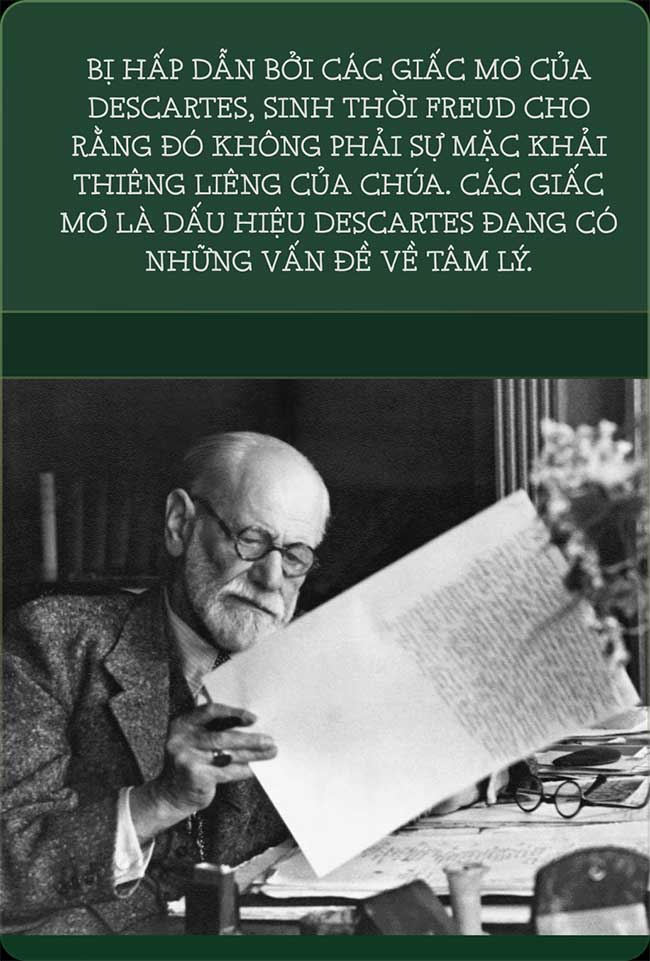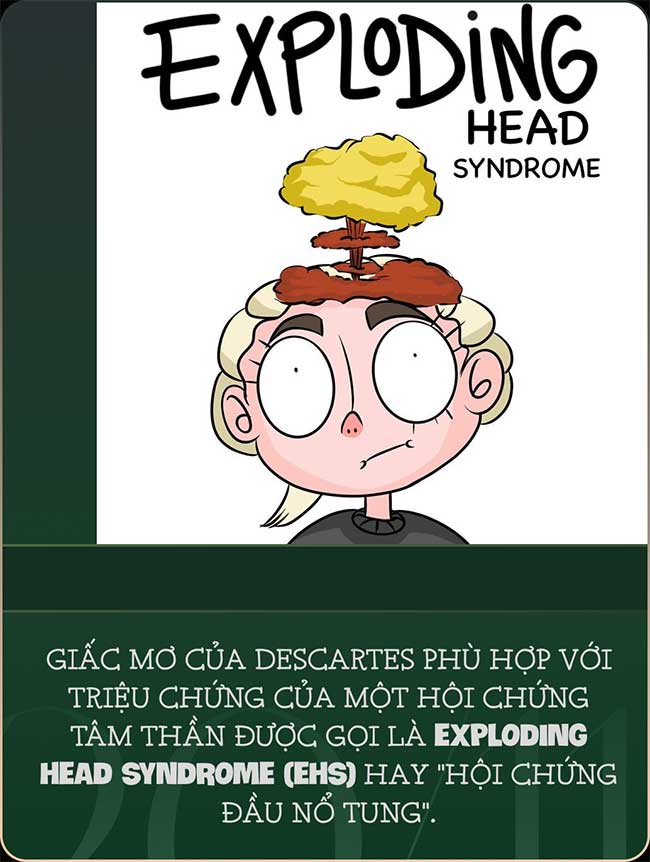Have you ever woken up suddenly from sleep, feeling like your head is about to explode? If you have had this experience, you might be experiencing a peculiar condition known as “Exploding Head Syndrome” (EHS).
Accurately translated from English, it is called “Hội chứng đầu nổ tung“. EHS falls into a group of sleep disorders collectively referred to as parasomnia, which includes sleep paralysis, also known as “nightmare”, and the phenomenon of waking up startled as if falling or free-falling in a dream.
At this point, there is bad news and good news.
The bad news is that scientists know very little about Exploding Head Syndrome. There is currently no treatment available for this strange condition.
So what is the good news?

It turns out that the genius French philosopher and mathematician René Descartes also experienced this syndrome. Just as an apple falling on Isaac Newton’s head led him to discover gravity, a dream in which his head exploded inspired Descartes to develop the entire field of analytic geometry and the foundations of modern philosophy.
So, the next time you wake up suddenly from a dream feeling like your head is about to explode, try to think of something. Who knows, you might just be the next person to etch your name into the annals of human history.
1. Descartes’ Revelatory Dreams
René Descartes, famous for the phrase “I think, therefore I am“, was a French scientist, mathematician, and philosopher who lived in the 17th century.
With his foundational statements for metaphysical skepticism and rationalism, Descartes emphasized that reason, not emotion, is what leads humanity to truth and knowledge.
Later philosophers built upon Descartes’ ideas to develop substantial doctrines, including dualism, which subsequently earned Descartes the title of “Father of Modern Philosophy.”

Moreover, Descartes made significant contributions to mathematics, where he integrated algebra and geometry to invent analytic geometry.
The Cartesian coordinate system, named after him, has helped mathematicians and physicists solve many challenging problems such as describing the motion of objects in space, planetary orbits, and solving quantum mechanical equations.
Even Einstein’s formulation of the Theory of Relativity relied on Descartes’ analytic geometry.
Today, Cartesian coordinates remain fundamental for computer graphics applications and 3D simulations. They are the foundation of all virtual worlds, from the online games you played as a child to Facebook’s fictional Metaverse.
It’s no wonder that the national high school math exams always feature geometry questions based on Cartesian coordinates.

Throughout his life, René Descartes had many significant breakthroughs in fields such as biology, psychology, and religion. But you may not know that all of Descartes’ revelations began with a dream when he was 23 – a prophetic dream that he believed was inspired by the “divine”.
However, looking back at history, scientists today believe that this dream was merely a sign of a psychological syndrome that Descartes unfortunately experienced.
2. What Did René Descartes See?
Everything began on the night of November 10, 1619, when Descartes experienced a total of three different dreams. But how do we know this for certain? It turns out that the French genius always kept a dream journal called Olympica, where he would write down all his dreams along with interpretations of them.
That night, Descartes recounted his three strange dreams. The first dream involved Descartes walking along a path when a strong wind swept him off balance, forcing him to lean and struggle to maintain his footing.
Feeling threatened by some malevolent force, Descartes sought refuge in a church. However, when he tried to enter, he realized he could not, feeling blocked by a mysterious power.
Upon waking from the dream, Descartes interpreted what had happened as a sign of doubt and uncertainty in life, where he faced difficulties and challenges in searching for truth and knowledge. His inability to enter the church symbolized obstacles in accessing salvation or liberation through religion.

The second dream described Descartes hearing a loud noise like thunder and waking up feeling extremely frightened. Descartes viewed this dream as a sign of the presence of supernatural forces, a warning from God.
This led him to reflect on the meaning of his life and God’s role in guiding him toward the path of knowledge. Descartes felt that the fear he experienced in this dream represented the challenges and reverence towards the power of the divine, which he must overcome to attain knowledge.
The third dream involved Descartes encountering a stranger who handed him a dictionary and a book titled Corpus Poetarum (meaning “The Collection of Poets’ Works“). When he opened it, he saw a quote: “Quod vitae sectabor iter?” (Which path should I pursue in life?). Another person then approached and praised a line of poetry, but Descartes could not recall what it was.
In this dream, Descartes felt he was being guided to follow the path of knowledge and science. The poetry book could symbolize the integration of art and science, while the question “Which path should I pursue in life?” suggested he was searching for direction in his life.

In his later records, Descartes believed that all three dreams were divine signs, guiding him toward the truths of science. Particularly the second dream, when Descartes heard a deafening bang. He woke up immediately only to find his room filled with shimmering light.
Descartes noted that he frequently experienced this phenomenon, and it felt like a revelation.
3. Divine Revelation or Just a Mental Syndrome?
Due to Descartes’ careful documentation of his dreams, for centuries they have become a scientific topic where many psychologists have delved in hopes of deciphering what Descartes experienced.
One of these was the famous Austrian neurologist and psychoanalyst, Sigmund Freud. Freud suggested that Descartes’ dreams stemmed from unresolved subconscious conflicts in his youth.
The loud noise Descartes heard in his second dream symbolized a strong event or emotion that had been repressed in his unconscious. It could represent a shocking past event or anxieties about the future that he could not control.
According to Freud, Descartes’ dreams were not divine revelations from God. They merely indicated that Descartes was experiencing psychological issues.

Freud’s conclusions, proposed in 1929, became the most plausible explanation for Descartes’ dreams over 300 years ago. However, it was also a time when neuroscience was just beginning to develop, and Hans Berger, a German neurologist, had just invented the electroencephalogram (EEG).
It wasn’t until nearly a century later, exactly 400 years after Descartes’ dreams, that they were truly understood.
In 2018, a study published in the Journal of Clinical Sleep Medicine first raised the question: “Could René Descartes have had Exploding Head Syndrome?”
The researchers noted that the second dream described by Descartes in his journal matched the symptoms of many patients suffering from a mental syndrome known as Exploding Head Syndrome (EHS).
EHS belongs to a group of sleep disorders collectively known as parasomnia, which includes sleep paralysis, also known as nightmares, and the phenomenon of waking up startled or feeling like falling or free-falling in dreams.
“Descartes’ experience after his first dream meets the diagnostic criteria for EHS as outlined in the International Classification of Sleep Disorders, Third Edition (ICSD-3),” the study states:
- First, he heard a sudden loud noise in his head when transitioning from sleep to wakefulness.
- Second, the explosion caused a sudden awakening and a feeling of fear.
- Third, the experience did not cause significant pain.

Additionally, the sparkling light that Descartes saw in his room after waking aligns with the hallucinations described by many patients suffering from Exploding Head Syndrome (EHS). There is no doubt that Descartes experienced the same sleep disorder that affects 1 in 10 people in the population.
4. What Causes Our Heads to “Explode”?
Despite being quite common, scientists have not yet delved deeply into research on Exploding Head Syndrome, leaving it a mystery that can easily be misunderstood as a revelation, as Descartes perceived it.
A study published in the journal Sage in 2017 reported that approximately 11% of the adult population has experienced dreams like Descartes at least once in their lifetime, meaning they too have awakened with their heads feeling “exploded” after hearing a loud noise such as a gunshot, drumbeat, or slamming door.
Another study published in the Journal of Sleep Research found that even 17% of college students have encountered EHS. Furthermore, another study revealed an even higher prevalence rate, with up to 33% of participants experiencing it, and around 6% experiencing Exploding Head Syndrome once a month.
Therefore, such revelatory dreams like Descartes’ are not too rare. So what is the cause? Where do these dreams originate? Why do we wake up with an explosion in our heads while sleeping?

Since Exploding Head Syndrome is a disorder that occurs in the twilight state between sleep and wakefulness, scientists suspect it originates from the brain’s reticular formation. The reticular formation is a collection of brain structures mainly located in the brainstem and hypothalamus, functioning as an “on-off” switch for the brain.
When the activity of the reticular formation slows down during our transition from wakefulness to sleep, our sensory cortex also ceases to function. This area controls our vision, hearing, and muscle movement, preventing us from sleepwalking at night.
An abnormality occurring in the reticular formation of the brain can lead to this switch being turned off or on suddenly, sending stimulating signals to our visual and auditory systems. As a result, we hear explosive sounds and experience visual hallucinations, such as a strong burst of light.
This is akin to flipping a light switch and seeing sparks fly from it.

Several medical conditions can lead to this situation, including:
- A mild seizure in the temporal lobe
- Post-traumatic stress disorder (PTSD)
- Damage or dysfunction of the inner ear structures
- Post-withdrawal syndrome from antidepressants
- Dysfunction of calcium channels in the brain
- Anxiety or stress disorders
5. Is This Syndrome Dangerous?
For Descartes specifically, the cause of his exploding head dream may have stemmed from a large tumor in his head.
As we know, Descartes did not live long. He died suddenly at the age of 53 in 1650 during a trip to the Swedish court to lecture Queen Christina.
His death remains a subject of much debate. Theodor Ebert, a German philosopher, suggested that Descartes was poisoned by Catholic preachers in Sweden who disagreed with his religious views presented to the royal family.

However, according to mainstream accounts, Descartes simply died of pneumonia. After his death, his body was buried in Stockholm. Sixteen years later, the French wished to move one of Descartes’ remains to France and conducted a reburial ceremony for him.
Descartes’ grave was exhumed, and his remains were then transferred to the church of Saint-Geneviève-du-Mont in Paris. However, during this process, Descartes’ skull was stolen by a guard named Planström.
Planström was in significant debt, so he took the risk and sold the skull of the renowned French philosopher to a collector of antiquities. Descartes’ skull then wandered for over 150 years, passed from one collection to another, until it was purchased by a gambling magnate in Sweden.
It wasn’t until 1821, when Jöns Jakob Berzelius, one of the pioneering Swedish chemists, learned of this, that he bought Descartes’ skull and returned it to France.
Since then, Descartes’ skull has been preserved and displayed at the Musée de l’Homme in Paris.

In 2014, a research team at the National Museum of Natural History in France conducted a CT scan of Descartes’ skull and unexpectedly discovered he had a massive tumor in his nasal cavity.
Although it was a benign tumor, researchers believe that this very tumor caused the French philosopher to frequently suffer from migraines, accompanied by auditory and visual hallucinations.
It is possible that it affected Descartes’ reticular system, leading him to experience revelatory dreams, which we now understand to be Exploding Head Syndrome.
Scientists state that in most cases, Exploding Head Syndrome is not dangerous. It merely causes feelings of fear and panic, with 45% of reported cases, but typically does not cause pain.
However, this also highlights the difference between benign Exploding Head Syndrome and something potentially more dangerous to your health.

Doctors suggest that if your Exploding Head Syndrome is accompanied by pain or seizures, you should seek immediate medical attention to rule out brain tumors. Otherwise, this condition – unlike its alarming name – is benign.
So next time you suddenly wake up to a loud explosion in your head like a gunshot, a slamming door, or thunder, rest assured, it’s just a hallucination. There’s nothing to fear; the world outside has not exploded, your city hasn’t been bombed, and no meteor has struck Earth.
If you’re feeling more confident, when experiencing Exploding Head Syndrome, try contemplating profound questions like Descartes did: “Quod vitae sectabor iter?” (What path shall I follow in life?), who knows, you might have a miraculous moment of your own?




















































